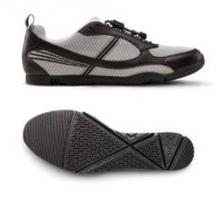A pilot study involving 16 people with osteoarthritis of the knee found that wearing specially designed shoes for 6 months significantly reduced knee loading, providing evidence that specialized footwear might be useful in the management of patients with OA of the knee, according to the investigators.
The improvements seen with the use of the shoes suggest "that footwear can be used as a mechanical device to achieve beneficial adaptations and alteration of gait with chronic use," said Dr. Najia Shakoor of the rheumatology section at Rush University, Chicago, and her associates.
In addition, after wearing the shoes for 6 months, the reduced load was evident even when the participants wore conventional shoes, suggesting "the presence of a gait adaptation with reductions in loading present even once the mobility shoes are removed," they added (Arthritis Rheum. 2013 April 10 [doi:10.1002/art.37896]).
Invented by Dr. Shakoor and one of her coauthors, Dr. Roy Lidtke, who is also at Rush, the mobility shoe has grooves that are "strategically placed at major flexion points of the foot to allow for natural, ‘barefoot-like’ movement of the foot," they said. In a previous study, they showed that the shoe mimicked the unloading effect of walking barefoot. They referred to evidence that elevated load on the knee joint in people with knee OA is associated with "radiographic severity, disease progression, and pain," and therefore, "reduction of loading at the knee may yield significant symptomatic benefits."
The patent for the shoe is owned by Rush University Medical Center, and if successful, the university will be paid for the licensing agreement and Dr. Shakoor and Dr. Lidtke also will receive some of the payments.
The study evaluated the effects of the shoes on the kinematics of gait in patients with medial compartment knee OA who were a mean age of 57 years. In the more symptomatic knee of each patient, the investigators measured the knee adduction moment (KAM) at 6, 12, and 24 weeks. KAM is a validated measure of medial compartment knee loading that has been associated with pain and progression of knee OA. Patients wore the shoes for at least 6 hours a day, 6 days a week (mean was 7 hours a day). Overall, 10 patients completed the study; the other 6 either dropped out because of a lack of effect or did not return for later visits; their results were included in the analysis.
At 24 weeks, the KAM was 18% lower when compared with measurements obtained at baseline, when the participants were wearing their regular shoes – a statistically significant difference. In addition, at 24 weeks, compared with baseline, the KAM was 11% lower while they were wearing their own shoes and 10% lower when walking barefoot, indicating that wearing the shoes may have "retrained" their gait, according to Dr. Shakoor and her associates.
Other findings included significant improvements in the pain of the affected knee, as measured by the Western Ontario and McMaster Universities Osteoarthritis Index (WOMAC).
This proof-of-principle study "provides support for the importance of footwear choice in the management of knee OA," the authors concluded. In previous studies, the authors showed that walking barefoot and wearing footwear designed to mimic barefoot mechanics was associated with reductions in knee loading, compared with wearing conventional footwear, but they had not determined the effects of the shoes over a longer period of time.
The study had limitations, including its sample size and follow-up duration of only 6 months, as well as the fact that the complete benefit of the shoes may not be clear until they are worn in a larger group of people for a longer period of time, the authors pointed out.
The study was supported by the Arthritis Foundation.


